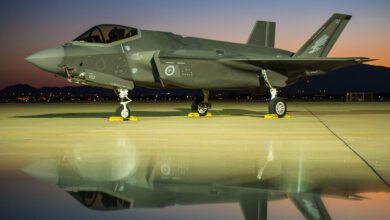
Hypersonic missiles have been thrown into the limelight due to their use by Russia against Ukraine.
This reinforces the belief that these weapons will be a mainstay in future conflicts. America, alongside Russia, China, India, and Iran, have or are developing hypersonics, but their usefulness in combat is up for debate.
A hypersonic missile can reach at least five times the speed of sound. While America and Russia have had this capability since the 1960s with intercontinental ballistic missiles, there are differences between ballistic and hypersonic missiles.
Flat Trajectory
Ballistic missiles travel in high arcs, sometimes reaching the edge of Earth’s atmosphere before coming down almost vertically to hit their targets. Hypersonics travel in a much flatter trajectory, sometimes just hundreds of feet above the ground. This is their main selling point.
Combined with high speed, this flat trajectory makes hypersonic missiles challenging to detect by radar and difficult to shoot down. Radars are mostly aimed upward to detect aircraft and conventional projectiles.
Hypersonics are maneuverable, capable of turning to avoid obstacles or choosing paths to hit targets unexpectedly. This makes them difficult to shoot down by modern anti-missile systems.
They can also be fired from land, sea, or air, a capability designed to maximize flexibility. However, the drawbacks of these missiles cannot be overlooked.
Drawbacks of Speed
The speed that makes these missiles prominent also negates their capabilities. Anything that travels at least five times the speed of sound needs to either slow down to turn or turn in a radius large enough to avoid damaging the missile.
This drawback also extends to hitting small or moving targets since any minor adjustment can easily be overcompensated for a missile traveling over a mile a second.
When a hypersonic slows down to turn or hit a moving target, it is vulnerable to close-range anti-missile systems like America’s Phalanx CIWS.
Best Use of Hypersonics
While hypersonic technology has been around for decades, the conflict in Ukraine has brought these weapons to the forefront of expert opinion.
While some challenges are presented by low trajectory missiles traveling at least Mach 5, the chances of success against small or mobile targets show that hypersonics are not the be-all and end-all of future conflicts.
Their best use will likely be against stationary targets of high importance in near-peer conflicts. China is exploring this option with its ground-launched DF-ZF, meant to deter America’s military from operating in the Pacific.
The US has countered with its own hypersonic, the AGM-183 ARRW, which will provide bombers with enough standoff distance to engage targets out to 1,000 miles (1,610 kilometers) in the near future.
Russia’s Zircon has been used in Ukraine, but with a lack of accurate target selection, the battlefield effect has been negligible.

Mainstay of Future Warfare?
Hypersonics have their role in current conflicts, but as seen with Russia’s war in Ukraine, their use makes all the difference.
China and America are the leaders in this field, with the mobility and number of launch platforms giving them the greatest potential battlefield impact.
Hypersonics aren’t going to be the mainstay of future warfare due to their drawbacks, but their use in quickly destroying more stationary targets from long distances will see their expansion in the arsenals of America and China as tensions continue to rise in the Pacific.
 Christopher Gettel is an 8-year US Army veteran who served with the National Guard and 82nd Airborne Division. He has been deployed to Iraq twice, including participation in the liberation of Mosul.
Christopher Gettel is an 8-year US Army veteran who served with the National Guard and 82nd Airborne Division. He has been deployed to Iraq twice, including participation in the liberation of Mosul.
Gettel recently finished a graduate certificate in Nuclear Deterrence from Harvard University’s Extension School and is now pursuing a master’s degree in International Security at George Mason University with the goal of completing a Ph.D. afterward.
Disclaimer: The views and opinions expressed here are those of the author and do not necessarily reflect the editorial position of The Defense Post.
The Defense Post aims to publish a wide range of high-quality opinion and analysis from a diverse array of people – do you want to send us yours? Click here to submit an op-ed.











